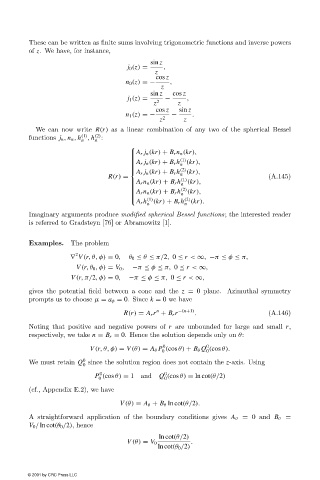Page 512 - Electromagnetics
P. 512
These can be written as finite sums involving trigonometric functions and inverse powers
of z. We have, for instance,
sin z
j 0 (z) = ,
z
cos z
n 0 (z) =− ,
z
sin z cos z
j 1 (z) = − ,
z 2 z
cos z sin z
n 1 (z) =− − .
z 2 z
We can now write R(r) as a linear combination of any two of the spherical Bessel
(2)
(1)
functions j n , n n , h , h :
n
n
A r j n (kr) + B r n n (kr),
(1)
A r j n (kr) + B r h (kr),
n
A r j n (kr) + B r h (kr),
(2)
n
R(r) = (A.145)
(1)
A r n n (kr) + B r h (kr),
n
(2)
A r n n (kr) + B r h (kr),
n
A r h (kr) + B r h (kr).
(1) (2)
n n
Imaginary arguments produce modified spherical Bessel functions; the interested reader
is referred to Gradsteyn [76] or Abramowitz [1].
Examples. The problem
2
∇ V (r,θ,φ) = 0, θ 0 ≤ θ ≤ π/2, 0 ≤ r < ∞, −π ≤ φ ≤ π,
V (r,θ 0 ,φ) = V 0 , −π ≤ φ ≤ π, 0 ≤ r < ∞,
V (r,π/2,φ) = 0, −π ≤ φ ≤ π, 0 ≤ r < ∞,
gives the potential field between a cone and the z = 0 plane. Azimuthal symmetry
prompts us to choose µ = a φ = 0. Since k = 0 we have
n
R(r) = A r r + B r r −(n+1) . (A.146)
Noting that positive and negative powers of r are unbounded for large and small r,
respectively, we take n = B r = 0. Hence the solution depends only on θ:
0 0
V (r,θ,φ) = V (θ) = A θ P (cos θ) + B θ Q (cos θ).
0 0
0
We must retain Q since the solution region does not contain the z-axis. Using
0
0
0
P (cos θ) = 1 and Q (cos θ) = ln cot(θ/2)
0 0
(cf., Appendix E.2), we have
V (θ) = A θ + B θ ln cot(θ/2).
A straightforward application of the boundary conditions gives A θ = 0 and B θ =
V 0 / ln cot(θ 0 /2), hence
ln cot(θ/2)
V (θ) = V 0 .
ln cot(θ 0 /2)
© 2001 by CRC Press LLC

